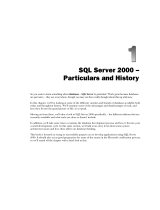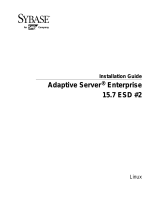
Page 10 Configuration and Tuning of Sybase System 11 for Microsoft Windows NT on Compaq Servers
1996 Compaq Computer Corporation, All Rights Reserved Doc No 143A/0596
If the server is dedicated to Sybase SQL Server, change the setting to
Best Foreground
Application Response Time
. If the server is not dedicated to Sybase SQL Server and is being
used to run other application programs or printer services then change the setting to
Foreground
and Background Applications Equally Responsive
.
Refer to the
Windows NT Resource Kit, Volume 4, Optimizing Windows NT
for more detailed
information on this topic.
By default, Sybase SQL Server threads
6
are started as variable priority class threads having a
base priority of 7-9. You can increase the base priority of the Sybase SQL Server threads before
starting Sybase SQL Server with the -P option. This starts the Sybase SQL Server threads with a
base priority of 13-15. We recommend using the -P option to boost Sybase SQL Server priority
on dedicated Sybase SQL Server MultiProcessor systems. On dedicated Sybase SQL Server
UniProcessor systems do not use the -P option.
The Sybase -P parameter will have a greater effect on the performance of your server than the
Tasking option setting.
Server Optimization should be set to
Maximize Throughput for Network Applications
,
7
this tells
Windows NT memory manager to allow Sybase SQL Server to manage its’ own memory area(s).
What you really are doing is altering the way Windows NT controls its’ memory optimization
routine from disk cache management to process working set management.
Refer to
Microsoft Windows NT Resource Kit, Volume 4, Optimizing Windows NT
and
Microsoft
Windows NT Server, System Guide
for a more detailed discussion.
The tunable parameter schedspins is now renamed as runnable process search count. The default
value of 2000 is satisfactory for most environments and no longer needs to be tuned except in
rare cases.
The sp_configure
max online engines
setting, determines how many CPU resources should be
dedicated exclusively to Sybase SQL Server. It is recommended on dedicated Sybase SQL Server
MultiProcessor systems that
max online engines
value be set equal to the number of CPUs in the
system. This option greatly increases performance, but since it can degrade performance of non-
Sybase SQL Server applications running on the same machine, it needs to be used only on
dedicated Sybase SQL Server MultiProcessor systems. Experimentation will be necessary to
obtain the best performance for your non-dedicated database server environment. If you set the
value for
max online engines
higher than the number of CPUs installed in your server, you will
still be able to run Sybase SQL Server but your overall system performance will be severely
impacted.
Unnecessary Services
You may turn off or stop all unnecessary services running on the server, since they add a
processing overhead on the system processor(s). Even though you can run with as few as two
services (
Server
and
Sybase SQL Server
), we recommend also running
EventLog
. You can
disable services such as
ClipBook Server, Computer Browser, Messenger, Network DDE,
Network DDE DSDM, Schedule
and others if you do not need them. You can turn these services
off through Control Panel/Services. Always monitor the behavior of your system, and reverse
any changes that impact performance or impair stability of your system.
6
You can check the priority of Sybase SQL Server threads via the Performance Monitor, Thread, Priority
Base and Priority Current for the Instance of sqlsrvr -> 0 through 15.
7
Some software packages may alter this setting so after installing any new software or changing any other
Windows NT settings check to insure that the proper setting of “Maximize Throughput for Network
Applications” is enabled.





















